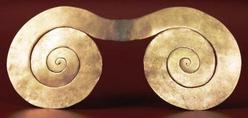The origins of the word “tumbaga” are obscure and complex, but the general consensus seems to indicate the word is a Malay word that means “copper, brass.” This is a little misleading, because tumbaga is actually a mixture of copper and gold. (Cesium is the only other “colored” metallic element – all other metallic elements are achromatic, greys and whites.) Today, the word is typically used to describe materials from pre-Columbian Central and South America.
Tumbaga is harder than copper, and like gold, it can be manipulated in a variety of methods – cast, hammered, engraved, etc. The mixture of the alloy varies, with some as high as 97% gold while others are as much as 97% copper. Some samples have traces of up to 18% of silver, other metals or impurities. It is believed that tumbaga objects were finished with a method of “depletion gilding,” likely being burned to oxidize the copper present on the surface and then treated with an acid wash to remove the oxidation, leaving a shiny surface that appeared to be pure gold.

A tumbaga ornament from the Tairona culture. (p4A item # D9925866)
In fact, some scholars have speculated that the use of tumbaga led to the legendary accounts of the South American cities of gold carried back to Europe by early explorers in the region, while others believe that tumbaga may have been orichalcum, the metal referred to in a number of ancient texts, including those with accounts of the fabled lost city of Atlantis.
Sadly, the depletion gilding process typically creates microscopic pitting on the surface of tumbaga objects, contributed to their eventual deterioration, as this pitting leaves the surface vulnerable to further oxidation. A terrific discovery was made in 1992 when a shipwreck was discovered in the Bahamas. Tumbaga objects plundered by the Spanish were typically melted down for transport, and then the tumbaga bars themselves were melted and separated back into their basic elements (gold, copper and silver) when they reach Europe. As a result, the 200 bars of tumbaga recovered from the shipwreck are believed to be the only bars in existence.



